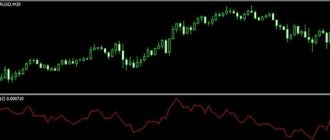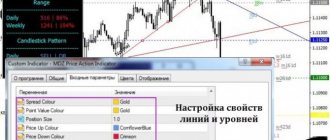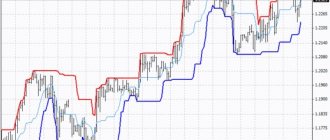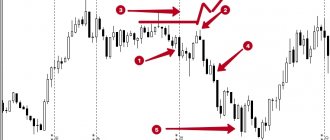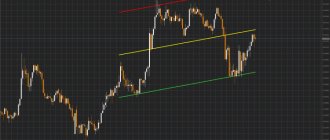From the article you will learn:
My warm greetings to all fans of financial markets and readers of this site! In this article we will look at the DPO (detrend price oscillator) indicator. In my opinion, this tool really has potential, and it's worth getting to know how it works. Perhaps it will be a worthy addition to your trading system.
In fact, the DPO indicator is a detrending tool. In simpler terms, its readings do not depend on the current trend developing in the market. This technical tool clearly shows the trader whether there is overbought or oversold within the market.
In addition, it can quite accurately indicate to us the potential lows and highs of the market, which we can use in practice. If you wait wisely for clear and fully formed signals from the DPO, then in the right hands it can bring quite a lot of profit. You can also make good money using the advisor opening an order at a given time. Let's return to the indicator.
Its essence is that in its testimony it does not rely on market trends , but seeks to look deeper; it considers changes in market cycles . An important feature of the DPO is the fact that in its testimony it does not consider long-term cycles; its prerogative is short-term market cycles. And he sells classical methods, which you can follow the link. And again to the indicator.
To carry out its calculations, the moving average is transformed into a straight line, and the price change chart, which is located above or below this average, becomes a price oscillator.
Speaking in a general context, this indicator is really interesting. Of course, I rarely see it being used in practice, but I believe that this is based only on the fact that it is really undervalued in the trading circle. It can also be used as a trailing stop method and trailingator is a good example of it.
Description of the Percentage Price Oscillator indicator
The Percentage Price Oscillator is the difference between the fast and slow moving average EMA, which is then divided by the slow EMA, and is calculated using the following formula:
When the faster moving average is above the slower moving average, it means the Percentage Price Oscillator indicator is positive and the market is currently bullish. When the faster moving average is below the slower moving average, it shows that the PPO is negative and reflects bearish momentum in the market.
The histogram represents the difference between the PPO and the 9-day EMA, which is also known as the signal line. The histogram is negative when the PPO is below the 9-day EMA, and the histogram is positive when the PPO is above the 9-day EMA.
(click on the screenshot to enlarge)
You can download the Percentage Price Oscillator indicator for free at the end of the article. For more information on installing indicators in MT4, see here.
PPO + Moving Averages Strategy
In this strategy, we combined the PPO indicator with moving averages to confirm trading signals.
The moving average is a leading indicator in the market and is quite popular among the trading community. Here we will use the default settings of the PPO indicator and the moving averages EMA 9 and EMA 15. These moving averages work well on small time frames. If you are a position trader, use the EMA 28 and EMA 40 moving averages.
Purchase example
When the EMA 9 moving average crosses the EMA 15 from below and the PPO indicator histogram is above the zero line and crosses, it indicates a bullish market.
On the USDCAD chart, we can see how the moving averages EMA 9 and EMA 15 give a buy signal, and the PPO indicator confirms this signal, and the market rushes higher.
(click on the screenshot to enlarge)
Always use the previous high to take profits. If the trend is strong enough, then take a 50% profit on the recent high and wait until the market makes a new higher high to exit the trade.
As always, we recommend setting a stop loss below the previous low. Because no strategy can make a profit every time.
This strategy works very well on lower time frames such as H1, M30 and M15.
Sales example
When the EMA 9 moving average crosses the EMA 15 from above and the PPO indicator moves below the zero line and crosses, it indicates a sell.
As you can see in the picture below, the USDCAD currency pair was in a downtrend. And at the pullback stage, the moving averages crossed downwards. At this stage, our strategy met half of the criteria. Later, the PPO indicator also dropped below the zero line and gave us a line crossover. This gave us the opportunity to open a sell trade.
(click on the screenshot to enlarge)
The problem with new traders is that most of the time they enter a trade when 50 percent of the strategy rules are met, and as a result, their trades more often than not hit a stop loss. The key to making money consistently in Forex is to always follow the rules of your trading plan.
Also, when you trade the market using this strategy, always follow the global trend on the higher time frame.
See also which scalping brokers offer the most favorable trading conditions.
DPO Indicator Information
The main feature of this indicator is the fact that it provides its readings in a simple and visual form. At its core, it is usually considered an oscillator, however, I personally cannot specifically attribute it to one group or another. In contrast, I would like to draw your attention to the very classic adviser vr setka. But I won’t distract you from the main topic.
The fact is that it simultaneously combines the features of trend indicators and oscillators. Here's a look at how the traffic light trading strategy works; its simplicity may compare favorably with the indicator considered here.
It is a basement indicator, displaying its readings in the form of a line, which will change its direction as the market moves.
How does the Detrend price oscillator base its readings? I won’t tell you long and tediously and describe the formulas; I think that few people will be interested in this. The fact is that it produces the ratio of current prices for the selected asset in relation to the moving average.
Article – Momentum Pinball
With all this, the main moving average has some displacement, and this was done for the purpose of smoothing. The fact is that DPO is designed for use on short-term trends. Accordingly, if the author of the indicator had not resorted to some kind of smoothing, the indicator would have reacted very sharply to changes within the market, which would inevitably lead to an increase in false signals.
Download
Compared to other oscillators, DPO more reliably indicates changes in short-term trends within the market. An important advantage from this is that this indicator will help to capture the beginning and end of short-term trends, which will be incredibly useful in trend trading.
That is, we will be able to enter almost at the end of the price correction in order to competently join the current trend.
This indicator is available in two versions: for the MT4 and MT5 platforms. As for the installation, everything is as usual, we just need to transfer all the files from the archive to the folder with the terminal, the Indicators section. And after launching the terminal itself, you will find it in Explorer, install it on the chart and start working.
If we talk specifically about the settings, then, in general, no changes need to be made. In my opinion, the standard parameters are quite enough to trade fairly well and accurately. However, if you wish, you can slightly adjust two parameters. Let's look at them in a second. Watch the video and pay attention to the practically indicator-free Forex sniper strategy.
Look
The first parameter is MA Period, which by default is 14. In fact, here we adjust the period of the main moving average, which is taken into account. It is clear that increasing the period will make the indicator smoother, and decreasing it will cause the indicator to react sharply to changes in the market.
There is one more parameter - BarstoCount, by default it is 300. That is, the last 300 bars from the history are taken into account when calculating the readings.
If you increase this parameter, the number of bars from history will increase. I repeat, I personally don’t see any point in changing the indicator settings, because they are optimal. But, again, everything is very individual here. Maybe you even want to use other approaches to Forex strategy for h4, advisors, signals, I don’t know.
PPO + MACD strategy
In this strategy we combine the Percentage Price Oscillator and the MACD indicator. Both of these indicators are oscillators. Other than a little calculation, there is no difference between the two.
Like PPO, MACD also consists of a center line, two moving averages and a histogram. However, if we compare both indicators, MACD is quite popular among traders and often reveals accurate signals.
When the PPO and MACD indicator rise above the zero line and give us a crossover, this indicates a buy signal. Conversely, when the PPO and MACD indicators fall below the zero line and give us a crossover, this indicates a sell signal.
Trust the signals only when both indicators cross near the zero line. If the PPO crosses near the zero line and the MACD goes well below the zero line and then crosses, then this is a sign of a trend reversal. Do not consider this as a signal to start trading.
Purchase example
Below is a chart of NZDUSD on the 15-minute timeframe. Since the pair was in an uptrend, we should only consider buying.
As you can see in the screenshot below, when the market was in the pullback phase, the PPO and MACD moving averages crossed above zero and the price soared higher. This is a buy signal.
(click on the screenshot to enlarge)
If the pullback is strong enough and both indicators give a signal to trigger the trade, always set the stop loss a little wider than the recent high because a strong pullback will often spike before moving in the direction of the original trend.
Sales example
Below is a chart of EURUSD on the 15-minute timeframe. As you can see, the market has been in a downtrend for quite a long time. When the price pulled back to the resistance line, the moving averages of both indicators crossed, indicating that the market would continue its downward trend.
(click on the screenshot to enlarge)
When trading a trend, always take partial profit at the recent low and the rest of the profit at the next resistance level. Also always use a stop loss above the resistance area or at the most recent high.
Principles of trading binary options
In the practice of trading binary options, there are two methods of interpreting Price Oscillator signals. The first of them takes into account the direction of the curve of the indicator line. When the curve moves from top to bottom, it is recommended to purchase Put contracts, while a reversal and movement from bottom to top symbolizes the activity of buyers and indicates a favorable situation for buying Call options.
At the same time, a zero level can be used to filter and make signals more correct. As soon as the curve crosses this level, heading down, you can confidently say that the bearish trend is stable and buy a put option. The reverse movement of the curve after crossing the zero level from bottom to top indicates the onset of a bearish trend and the prospect of buying call options.
Limitations of the Percentage Price Oscillator indicator
The PPO indicator is prone to reversals on lower time frames and sometimes gives false signals of moving average crossovers. During a fading trend or in a range-bound market, center line crosses often provide many buy/sell signals. But these signals usually don't work. This indicator also detects divergences in the market. However, in a trending market, divergence often does not work.
See also TOP 5 brokers with cryptocurrency trading.
conclusions
The Percentage Price Oscillator is a momentum indicator. It is one of the best oscillators for identifying divergence, overbought and oversold conditions. It also reflects well the convergence and divergence of two moving averages. The default settings for the PPO indicator are 12, 26, and 9. You can change these settings to increase or decrease its sensitivity. You can also remove the histogram by setting the signal line value to 1. Use this indicator in your daily trading activities to generate reliable trading signals. Happy trading!
Free download of the Percentage Price Oscillator indicator
What is the Normalized volume oscillator indicator and where to download it
NVO is a technical indicator that allows you to see tick volumes in the market. This abbreviation stands for Normalized volume oscillator. Let's take a closer look at its functionality and application.
Description of the tool
No indicator can accurately measure market volumes. But they can be calculated indirectly using average values and obtain so-called tick volumes. This is exactly what the NVO algorithm does. It reflects the calculation results on a chart - it can be a curved line or columns (depending on the version of the indicator).
Thanks to this, a trader can quickly understand:
- trend direction;
- volumes (based on indirect data) for sale and purchase;
- at what points the trend can reverse.
NVO installation
There is no NVO in the basic set of MT4 indicators. Therefore, you need to add it to the “Indicators” folder. To find it, go to the program, go to the top panel (“File”), then click on the “Open directory” line. There is “MQL4”, which contains the “Indicators” folder we need.
Further sequence of actions:
- Paste all files into this folder.
- Restart the program.
- Add an instrument to the chart via the navigator panel.
It can also be plotted on a chart through the “Insert” menu (go to “Indicators”, then to “Custom” and find “NVO”).
As a result, a new indicator in the form of colored bars will appear under the chart.
Advice. The basic settings of the algorithm should not be changed. But sometimes traders adjust them. To do this, right-click on any part of the indicator and go to the “Properties” section. In the window that opens, you can change the color of the columns, as well as the “Volume Period”. This is the number of candles that are taken into account in NVO calculations. The default period is 10.
Normalized volume oscillator versions and their signals
As already mentioned, 2 versions of the NVO indicator have been developed:
- In the form of a curved line.
- In the form of colored columns (as shown above).
The line moves in different directions. If it goes down, this indicates an increase in the volume of SELL sales, and if it goes up, it indicates an increase in BUY purchases. But this version is not very convenient, because the curve does not clearly show the strength of the trend.
To determine the trend, we recommend additionally installing the Power Fuse indicator in the terminal. It combines the functions of McD and Bollinger Bands and shows which way the price is moving and where it might turn around.
At the same time, the bars reflect this indicator well - the larger they are, the stronger the current trend. Therefore, it is the second version of the indicator that is most often used in real trading. The signals depend on the color and size of the columns:
- Blue – medium volumes.
- Green – volumes have become slightly higher than average (increase to 38.2%).
- Light green – volumes exceeded average values (increase in the range of 38.2-61.8%).
- Yellow – a significant increase in volumes (in the range of 61.8-100%).
- Red or orange – volumes have increased critically (more than 100%).
The entry rule is very simple: the stronger the increase in volume, the stronger the signal about a trend reversal. For example, if the bars are blue, this indicates a flat in the market. Price changes are insignificant, it moves up and down. Therefore, there is no clear trend, there is no need to enter the market - there may be false signals.
Green – the probability of a reversal increases, although not too much. You can open trades on yellow or red (they appear least often) columns. They indicate a sharp change in volumes, which often leads to a change in trend.
Thus, when opening transactions, you need to take into account 2 patterns:
- If volumes increase, the likelihood of a trend reversal increases.
- If volumes fall, the probability of a flat increases.
Ideally, you should only fish the orange (red) bars. At this moment, the interest of market players increases significantly, which indicates an increase in the volume of transactions (buy or sell). As a result, an imbalance arises between supply and demand, which causes the price to move:
- up (if demand exceeds supply);
- down (if supply exceeds demand).
When such moments appear, you need to open new transactions or “build up” old positions.





